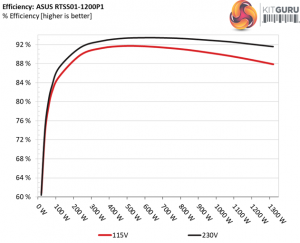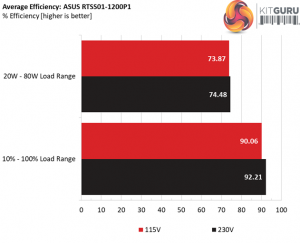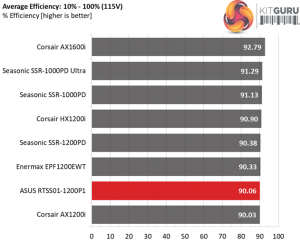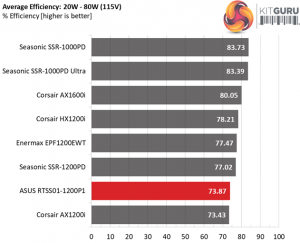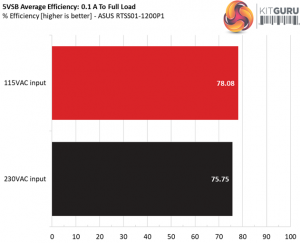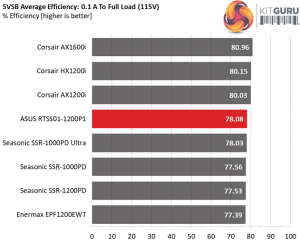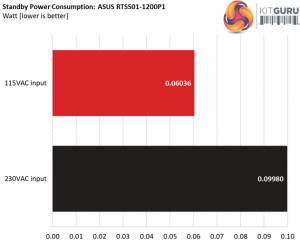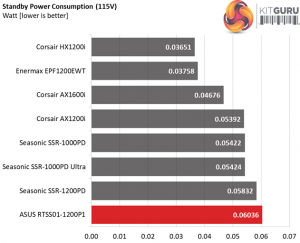Efficiency
Our efficiency testing procedure is detailed here.
Using results from the previous page, we plotted a chart showing the PSU's efficiency at low loads, and loads from 10 to 110 percent of its maximum-rated capacity.
Compared to similar spec platforms the Asus unit stays behind. With normal loads the difference is minimal, however with light loads it is significant. Obviously the OLED screen and the extra power required by the micro-controller, are the main culprits for this.
Efficiency At Low Loads
In the following tests, we measure the RTSS01-1200P1's efficiency at loads significantly lower than 10 percent of its maximum capacity (the lowest load the 80 PLUS standard measures). The loads we dial are 20, 40, 60, and 80W. This is important for representing when a PC is idle, with power-saving features turned on.
| Test # | 12V | 5V | 3.3V | 5VSB | DC/AC (Watts) | Efficiency | Fan Speed (RPM) | PSU Noise (dB[A]) | PF/AC Volts |
| 1 | 1.185A | 0.502A | 0.480A | 0.196A | 19.583 | 60.811% | 0 | <6.0 | 0.816 |
| 12.220V | 4.984V | 3.326V | 5.119V | 32.203 (*33) | 115.06V | ||||
| 2 | 2.425A | 1.002A | 0.993A | 0.391A | 39.940 | 73.598% | 0 | <6.0 | 0.889 |
| 12.228V | 4.979V | 3.322V | 5.111V | 54.268(*53) | 115.05V | ||||
| 3 | 3.603A | 1.507A | 1.473A | 5.105A | 59.461 | 78.873% | 0 | <6.0 | 0.918 |
| 12.230V | 4.978V | 3.322V | 5.105V | 75.388 (*75) | 115.05V | ||||
| 4 | 4.845A | 2.011A | 1.985A | 0.785A | 79.851 | 82.182% | 567 | 11.1 | 0.943 |
| 12.228V | 4.978V | 3.321V | 5.099V | 97.164 (*96) | 115.05V |
*Readings acquired by the PSU's OLED screen. As you can see they are pretty close to the real ones.
The PSU operates in passive mode through out the first three tests and although no power is spent on the fan's operation, still the registered efficiency levels are low. We strongly believe that the OLED screen and its controller are to blame for the not so good efficiency results under light loads.
5VSB Efficiency
The ATX specification (revision 1.4), along with CEC, ErP Lot 3 2014 and ErP Lot 6 2010/2013, states that the 5VSB standby supply efficiency should be as high as possible, recommending 75 percent or higher with 550mA, 1A, and 1.5A of load.
The supply should also achieve higher than 75% efficiency at 5VSB under full load, or with 3A if its max current output on this rail is higher than 3A.
We take six measurements: one each at 100, 250, 550, 1000, and 1500mA, and one with the full load the 5VSB rail can handle.
| Test # | 5VSB | DC/AC (Watts) |
Efficiency | PF/AC Volts |
| 1 | 0.100A | 0.513 | 73.707% | 0.067 |
| 5.127V | 0.696 | 115.05V | ||
| 2 | 0.250A | 1.281 | 78.253% | 0.147 |
| 5.123V | 1.637 | 115.05V | ||
| 3 | 0.550A | 2.814 | 80.515% | 0.262 |
| 5.115V | 3.495 | 115.05V | ||
| 4 | 1.000A | 5.104 | 80.657% | 0.359 |
| 5.104V | 6.328 | 115.05V | ||
| 5 | 1.500A | 7.638 | 80.860% | 0.414 |
| 5.092V | 9.446 | 115.05V | ||
| 6 | 3.000A | 15.171 | 79.696% | 0.484 |
| 5.057V | 19.036 | 115.05V |
The 5VSB rail is highly efficient and only loses to CWT's and Flextronics' top implementations.
Power Consumption In Idle And Standby
In the table below, you’ll find the power consumption and voltage values of all rails (except -12V) when the PSU is idle (powered on, but without any load on its rails), and the power consumption when the unit is in standby mode (without any load, at 5VSB).
| Mode | 12V | 5V | 3.3V | 5VSB | Watts | PF/AC Volts |
| Idle | 12.198V | 4.994V | 3.330V | 5.129V | 12.838 | 0.586 |
| 115.1V | ||||||
| Standby | 0.060 | 0.006 | ||||
| 115.1V | ||||||
The vampire power levels are low, however the competition is super tough here.
Fan RPM, Delta Temperature, And Output Noise
Our mixed noise testing is described in detail here.
The first chart below illustrates the cooling fan's speed (in RPM), and the delta between input and output temperature. The results were obtained at 37°C (98.6°F) to 47°C (116.6°F) ambient temperature.
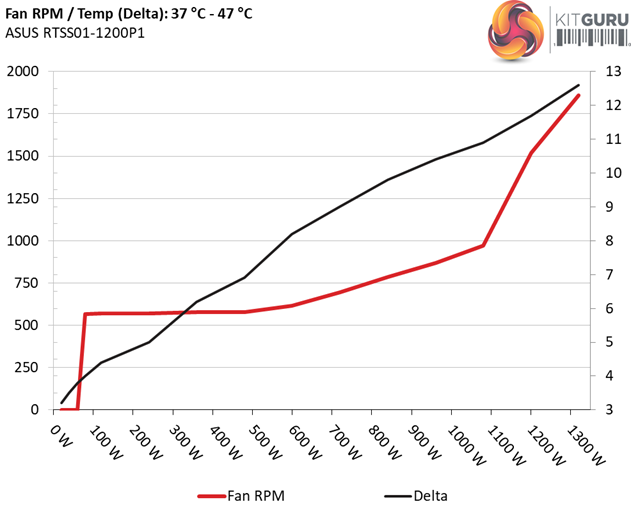
The next chart shows the cooling fan's speed (again, in RPM) and output noise. We measure acoustics from one meter away, inside a hemi-anechoic chamber. Background noise inside the chamber is below 6 dB(A) during testing (it's actually much lower, but our sound meter’s microphone hits its floor), and the results are obtained with the PSU operating at 37°C (98.6°F) to 47°C (116.6°F) ambient temperature.

The following graph illustrates the fan's output noise over the PSU's operating range. The same conditions of the above graph apply to our measurements, though the ambient temperature is between 30°C (86°F) to 32°C (89.6°F).
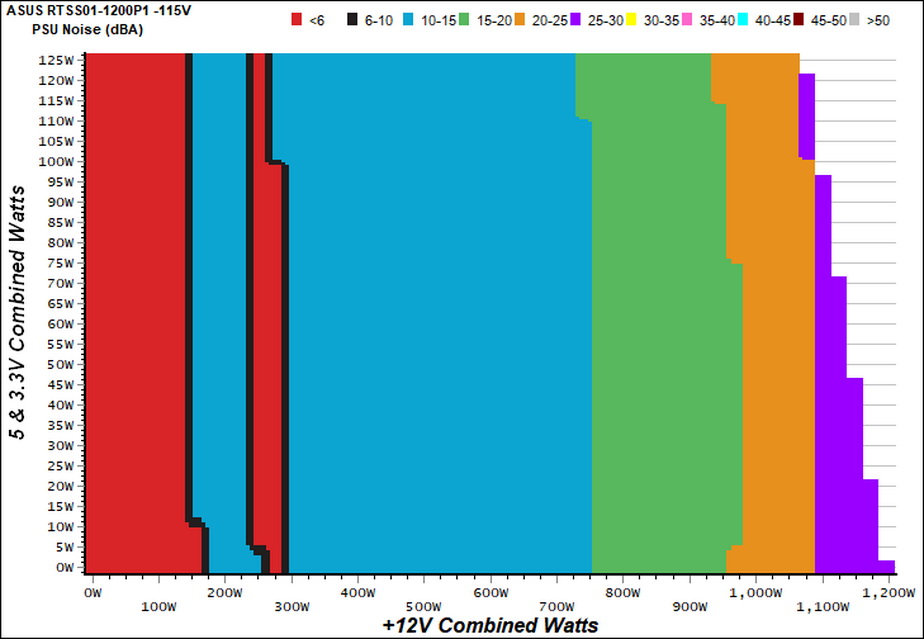
The semi-passive operation doesn't last long, probably because we apply heavy stress to the DC-DC converters. Up to 750W load the output noise is at very low levels (<15 dB[A]) and even with higher than 1100W load the noise is kept below 30 dB(A). As we already stated this is a super quiet PSU, ideal for users that hate noisy components, but still need lots of power.
Be sure to check out our sponsors store EKWB here
 KitGuru KitGuru.net – Tech News | Hardware News | Hardware Reviews | IOS | Mobile | Gaming | Graphics Cards
KitGuru KitGuru.net – Tech News | Hardware News | Hardware Reviews | IOS | Mobile | Gaming | Graphics Cards


